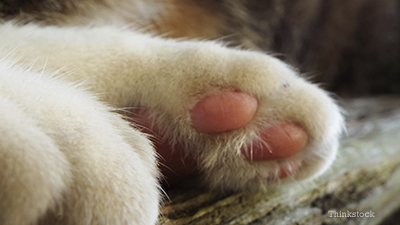

What is feline plasma cell pododermatitis?
Plasma cell pododermatitis (a mouthful, I know) is an inflammatory disease that affects the footpads of cats. The pads become infiltrated by plasma cells, a type of white blood cell. What are plasma cells? They’re immune cells that would normally secrete antibodies in response to an infection.
Who is affected by feline plasma cell pododermatitis?
Feline plasma cell pododermatitis can affect any age, gender, or breed of cat. Luckily it is an uncommon, dermatological disease.
Symptoms of feline plasma cell pododermatitis
Pododermatitis can affect any footpad, but most commonly it involves the large or central pad of the front or back feet (called the metacarpal or metatarsal pads). Generally, all four feet are affected, but occasionally a cat will have only one affected foot.
Affected pads are typically:
- Swollen
- Soft
- Scaly
- Ulcerated
- Quick to bleed.
The pads might then become painful and cause your cat to limp. Cats with feline plasma cell pododermatitis also often lick or chew at their feet.
Cause of feline plasma cell pododermatitis
The exact cause of feline plasma cell pododermatitis is unknown. Many veterinary dermatologists believe it is immune mediated or an allergic reaction. Some recent reports suggest feline plasma cell pododermatitis may be linked to feline immunodeficiency virus (FIV). However, the exact relationship between FIV and feline plasma cell pododermatitis still remains unknown.
Diagnosis of feline plasma cell pododermatitis
If you discover that your cat has soft, swollen, tender, scaly footpads, be sure to bring him to your veterinarian for an examination.
- Your veterinarian may recommend screening your cat for FIV
- Your veterinarian may suggest a fine needle aspirate or biopsy of the affected pads
Treatment of feline plasma cell pododermatitis
Since it is believed that feline plasma cell pododermatitis is due to an underlying activation of the immune system, treatment is aimed at controlling the immune response. Some mild cases of feline plasma cell pododermatitis regress spontaneously without treatment. More advanced or painful lesions are commonly treated with doxycycline or steroids. Depending on the severity of the lesions, some veterinarians will also bandage the feet and utilize other antibiotics and pain medication if needed. In addition to treating the affected footpads, your veterinarian may recommend an allergy workup if an underlying allergy is suspected. This may include:
- Year-round parasite control
- Food trials
- Testing for environmental allergies
Prognosis of feline plasma cell pododermatitis
Most cases of feline plasma cell pododermatitis respond to treatment, though it may take a few months to resolve.
For more information about this disease, speak with your veterinarian.
Questions to ask your veterinarian:
- Does my cat need pain medication?
- Should I use special cat litter while his foot is affected?
- When should I come back for a check-up?
If you have any questions or concerns, you should always visit or call your veterinarian -- they are your best resource to ensure the health and well-being of your pets.
